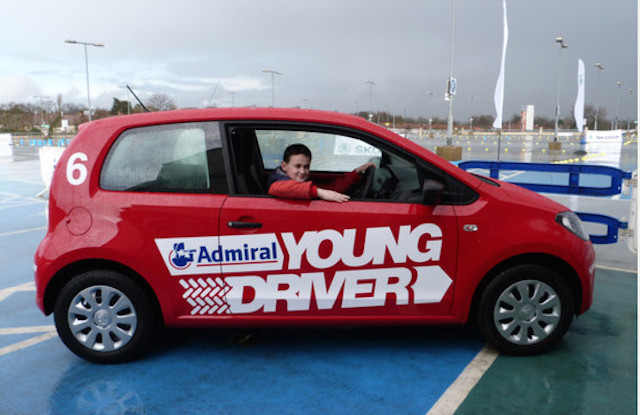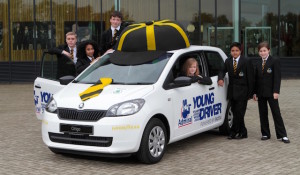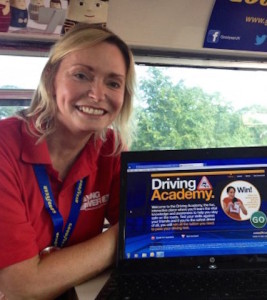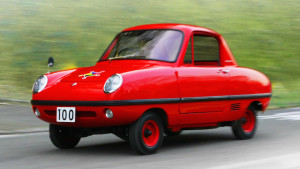

The chief instructor behind a UK company that gives driving lessons to children as young as 11 has a compelling argument for doing so: “When you are learning piano or violin, you don’t start at 17 – you start at 5.”
And that’s Richard Smith’s next step, teaching five-year-olds a few basic skills on private roads in purpose-built electric mini cars.
Smith is the guiding hand for Young Driver, the company offering lessons all over Great Britain to kids not yet old enough for on-road instruction.
More than 300,000 kids have been through the programme at 40 venues. And the records show, says Smith, that graduates have a nine per cent accident rate compared with upwards of 20 per cent for the general UK population.
“There’s a reason that our title sponsor is an insurance company,” Smith told BBC magazine.

Young Driver uses manual model Skoda Citigos, modified for dual control. The lessons are run on private property, usually company car parks not in use on weekends.
Students learn to deal with intersections, two-way traffic, roundabouts and traffic signals, parallel parking and even slalom courses.
For advanced students there are courses on emergency braking, driving in bad weather, higher speed manoeuvers.
Of course the Skodas can be driven only by tweenagers tall enough to see over the steering wheel and reach the clutch, brake, and throttle.
Like Callum McNeilly, 13, who has been taking lessons for 18 months. “I love cars and wanted to take a step into actually driving a real car as opposed to using a steering wheel on a gaming console.”
But for those younger than 11, Smith and Young Driver director Kim Stanton could find only pedal cars. So they contracted a car designer to build a real pint-sized trainer.

The result is an electric car two metres long and one metre wide. It has indicators, headlights, disc brakes, seat belts and a suspension set-up that makes it handle like the real thing.
Said Stanton: “This is not a toy, it is very definitely a small car. We’ve had children involved throughout its development, working with the designers and engineers to ensure that it provides a realistic driving experience.”
Additional safety measures include a patent-pending system that identifies obstacles and stops the car, an instructor’s kill switch, and a device that can stop the car remotely.
Under the tiny bonnet are electric motors running on conventional batteries, power enough for 10 hours running time or a range of 55km. Young Driver has code-named it Electric Trainer One, or ‘ET1’.
It unveiled it at a gadget show at the NEC centre in Birmingham, where it pulled in the kids like the Pied Piper of Hamlyn. More than 1000 queued to take it for a spin.
“We had estimated that we’d build 50 for use in instruction, but we’ve had so much interest that we’ll certainly be making more,” said Smith, adding that each car costs “somewhat nearer to £5000 than £3000”. That’s roughly $NZ10,000 to $NZ6000.
 • In 1965, Japanese carmaker Datsun introduced a special car for a very small segment of the market. Fittingly dubbed the Baby (pictured at right), the tiny two-seater was designed and developed as a serious tool for teaching safe-driving techniques to the short-pants set at a Tokyo-area theme park called Kodomo no Kuni (Children’s Land). The little coupe – whose looks evoked a 1963 Alfa Romeo Giulietta Sprint Speciale – featured a fully independent suspension with a double wishbone setup up front; mirrors, wipers and crank windows; street-legal headlamps and turn indicators; and a full-size steering wheel with a spring-actuated self-turning mechanism. A 200cc single-cylinder engine spurred the Baby to a governed top speed of 30km/h. Last year, Datsun parent Nissan celebrated the Kodomo no Kuni’s 50th anniversary by unveiling a lovingly restored Baby. – BBC magazine
• In 1965, Japanese carmaker Datsun introduced a special car for a very small segment of the market. Fittingly dubbed the Baby (pictured at right), the tiny two-seater was designed and developed as a serious tool for teaching safe-driving techniques to the short-pants set at a Tokyo-area theme park called Kodomo no Kuni (Children’s Land). The little coupe – whose looks evoked a 1963 Alfa Romeo Giulietta Sprint Speciale – featured a fully independent suspension with a double wishbone setup up front; mirrors, wipers and crank windows; street-legal headlamps and turn indicators; and a full-size steering wheel with a spring-actuated self-turning mechanism. A 200cc single-cylinder engine spurred the Baby to a governed top speed of 30km/h. Last year, Datsun parent Nissan celebrated the Kodomo no Kuni’s 50th anniversary by unveiling a lovingly restored Baby. – BBC magazine
